Influence of proximity to the Qinghai-Tibet highway and railway on variations of soil heavy metal concentrations and bacterial community diversity on the Tibetan Plateau
Xia Zhao,JunFeng Wang,Yun Wang,Xiang Lu,ShaoFang Liu,YuBao Zhang,ZhiHong Guo,ZhongKui Xie,RuoYu Wang*
1.Gaolan Station of Agricultural and Ecological Experiment,Northwest Institute of Eco-Environment and Resources,Chinese Academy of Sciences,Lanzhou,Gansu 730000,China
2. Key Laboratory of Stress Physiology and Ecology in Cold and Arid Regions of Gansu Province, Lanzhou, Gansu 730000,China
3. State Key Laboratory of Frozen Soil Engineering, Northwest Institute of Eco-Environment and Resources, Chinese Academy of Sciences,Lanzhou,Gansu 730000,China
4. Key Laboratory of Desert and Desertification, Northwest Institute of Eco-Environment and Resources, Chinese Academy of Sciences,Lanzhou,Gansu 730000,China
ABSTRACT An understanding of soil microbial communities is crucial in roadside soil environmental assessments.The 16S rRNA sequencing of a stressed microbial community in soil adjacent to the Qinghai-Tibet Highway (QTH) revealed that the accumulation of heavy metals(over about 10 years)has affected the diversity of bacterial abundance and microbial community structure. The proximity of a sampling site to the QTH/Qinghai-Tibet Railway (QTR), which is effectively a measure of the density of human engineering, was the dominant factor influencing bacterial community diversity. The diversity of bacterial communities shows that 16S rRNA gene abundance decreased in relation to proximity to the QTH and QTR in both alpine wetland and meadow areas. The dominant phyla across all samples were Actinobacteria and Proteobacteria.The concentration of Cr and Cd in the soil were positively correlated with proximity to the QTH and QTR (MC/WC sampling sites), and Ni, Co, and V were positively correlated with proximity to the QTH and QTR (MA/WA sampling sites).The results presented in this study provide an insight into the relationships among heavy metals and soil microbial communities, and have important implications for assessing and predicting the impacts of human-induced activities from the QTH and QTR in such an extreme and fragile environment.
Keywords: Qinghai-Tibet Highway (QTH); Qinghai-Tibet Railway (QTR); soil bacterial community; alpine wetland;alpine meadow;heavy metal
1 Introduction
As the geographical unit with the highest elevation on earth, the Qinghai-Tibet Plateau (QTP) is referred to as the"Third Pole"and has an important role in regulating climate change and water resources in East Asia and even for the whole world (Qiu, 2008).However, as a fragile ecosystem, the high risk of a decline in the extent of the Tibetan alpine tundra on the QTP is of great concern due to the release of microbes and the destabilization of human infrastructure (Qiu,1980; He et al., 1987; Chen and Wu, 2000; An et al.,2001; Wu et al., 2007; Schuur et al., 2011). This QTP ecosystem is extremely sensitive to human activity, especially the Qinghai-Tibetan Railway (QTR) and Qinghai-Tibetan Highway (QTH) (Jin et al., 2008; Kou et al., 2017).As the most important transportation routes in the region, they are driving the growth of the local economy by crossing a large part of the permafrost region on the QTP in Tibet, China (Wu and Zhang,2008).Disturbance or destruction of the vegetative mat is unavoidable and has led to the onset of warming/thawing of the underlying permafrost and destruction of the adjacent soil environment (Wu and Shi, 2002;Zhang,2005;Dinget al.,2006;Gaoet al.,2009).
The QTR and QTH are significant sources of heavy metal and organic pollution from vehicular abrasion and track material abrasion (Baath, 1989;Pagotto et al.,2001).The enriched heavy metal particulate matter that is generated by abrasion ultimately settles in the surrounding soils where it can persist for a long time due to the low degradability (Liu et al.,2009; Zhang et al., 2012). This particulate matter can influence soil microorganisms, plant growth, and human health (Brookes, 1995; Nagajyoti et al., 2010; Li et al., 2014). As an important component of ecosystems,soil microorganisms are involved in organic material degradation, biogeochemical cycling, and the maintenance of soil structure (Schmidt et al., 2011).However, soil microbial biomass, activities and community structure can still be changed by heavy metals,and bacterial communities can therefore be sensitive indicators for contaminant stress, particularly metal contamination (Giller et al., 1998; Yang et al., 2006;Wang et al.,2010).Moreover,over 90% of the energy flow in the soil ecosystem is mediated by microbes(Nannipieri and Badalucco, 2003). Numerous reviews have been published on the utilization of soil microbial properties as indicators of soil quality (Schloter et al., 2003; Bloem et al., 2006; Ritz et al., 2009). In any case,heavy metals can alter the role of soil microorganisms in the recycling of organic matter and plant nutrients (Belyaeva et al., 2005). Most previous studies have focused on climate change on the QTP, with relatively little attention being paid to the effects on soil microorganisms due to disturbances from the QTR and QTH. The roadside soil along the QTH is a useful research material to explore the effects of heavy metal enrichment and bacterial community structures due to the limited opportunities for disturbance from human activity.
In this study,we examined soil bacterial communities that were potentially impacted by the QTH and QTR in two ecotype areas on the QTP. We aimed to determine whether there were clear patterns in the changes of the soil bacteria community and heavy metal enrichment in alpine wetland and meadow ecosystems. We tested the following hypotheses: (i) the diversity of the soil bacterial community differs with distance from the QTH and QTR; (ii) in alpine meadow and wetland areas, there are similar trends in changes of bacterial diversity; and (iii) heavy metal content is related to the bacterial community diversity over a range of distances from the QTH and QTR.
2 Materials and methods
2.1 Sample collection
A total of 24 samples were collected from disturbed roadside regions along the QTH on the QTP in October 2015. All samples (with three replications)were collected from the top 10 cm soil layer, at 10 m from the roadside in two different ecosystems (alpine wetland and meadow). Twelve samples were taken from alpine wetland areas as follows;three from the intersection (<10 m) of the QTH and QTR (34°5.88'N,92°20.633'E)at 4,769 m elevation(WA1,WA2,WA3),three at 100 m from the QTR(34°6.187'N,92°20.937'E)at 4,759 m elevation (WB1, WB2, WB3), three at 600 m from the QTR (34°5.299'N, 92°20.308'E) at 4,787 m elevation (WC1,WC2,WC3) along the QTH,and three control samples were taken at a location that was distant from both the QTH and QTR (WCK1,WCK2, WCK3). Twelve samples were taken from alpine meadow areas as follows; three from the intersection of the QTH and QTR (34°15.925'N, 92°28.831'E)at 4,579 m elevation (MA1, MA2, MA3), three at 72 m from the QTR (34°22.897'N, 92°38.383'E) at 4,618 m elevation (MB1, MB2, MB3), three at 450 m from the QTR (34°18.700'N, 92°32.715'E) at 4,612 m elevation (MC1, MC2, MC3) along the QTH, and three control samples were taken at a location that was distant from both the QTH and QTR (MCK1,MCK2, MCK3). There were three replicates for all samples. Each sample consisted of soil from five sites approximately 1 m apart that were then pooled to achieve an equal-weight of soil.
2.2 Soil physicochemical analyses
Organic carbon in the soil extracts was determined by the potassium bichromate oxidation method. The unreacted potassium dichromate was determined by titration with ferrous ammonium sulfate(Kalembasa and Jenkinson, 1973). The total nitrogen content of soil was determined using the Kjeldahl method(Bremner,1960).The size fractionation procedure was based on the method of Jocteur Monrnozier(Monrozier et al., 1991). Soil pH was measured by a soil survey standard test method at a ratio of 1:2.5(soil/water,w/w)(Rayment and Higginson,1992).
Soil samples were analyzed by inductively coupled plasma mass spectrometry (ICP-MS) at Lanzhou University, China, using an Agilent 7700 X model ICP-MS system (Agilent, Santa Clara, CA, USA). A total of eight heavy metals (Ni,Cr,Cd,Pb,Co,V,Cu,and Zn) were analyzed in the soil samples. Before analyzing the heavy metals by ICP-MS, a microwave oven equipped with polytetrafluoroethylene (PTFE)vessels, (Ethos One, Milestone, Sorisole, Italy), was used for sample digestion. Concentrated nitric acid (6 mL), hydrochloric acid (2 mL), and hydrofluoric acid(2 mL) was used to digest 0.05 g dried soil sample to liquid. This solution was further diluted 1:9 (solution:nitric acid)for the ICP-MS analysis.
2.3 Polymerase chain reaction (PCR) amplification and Hiseq 2500 sequencing
To reduce environmental interference, the soil DNA was extracted immediately after its arrival in the laboratory. Bacterial community DNA was extracted from soil samples using an E.Z.N.A.®Soil DNA Kit(Omega Bio-Tek, Inc., Norcross, GA, USA) according to the manufacturer's protocol. High-throughput sequencing was conducted at Biomarker Technologies Co., Ltd. (Beijing, China) The 338F (ACTCCTACGGGAGGCAGCA) and 806R (GGACTACHVGGGTWTCTAAT) primers were used to amplify the bacterial 16S rRNA V3-V4 fragments (about 470 bp). The PCR amplification was conducted using a phusion high-fidelity DNA polymerase (New England Biolabs, Ipswich, MA, USA). The PCR thermal cycle profile was as follows: 5 min at 95 °C; 25 cycles of 30 s at 95 °C, 30 s at 50 °C, 40 s at 72 °C; 7 min at 72 °C, and finally cooling at 4 °C.A MinElute®PCR purification kit (Qiagen, Venlo, The Netherlands) was used to collect DNA amplification fragments. The samples and VAHTSTM DNA clean beads were fixed to the filtrate at a ratio of 1:1.5. The sequencing was carried out on a HiseqTM2500.
2.4 Statistical analysis
Statistical analyses were conducted using SPSS,version 19.0 Software (SPSS, Chicago, IL, USA). Results were expressed as the mean±standard deviation.A oneway analysis of variance (ANOVA) and a Duncan's Multiple Range test (DMRT) were used to compare the data. Statistical significance was accepted at P <0.05,with P<0.01 indicating a high level of statistical significance. Principal component analysis (PCA) and canonical correspondence analysis (CCA) were performed using Canoco™version 5.0 software(Ithaca,NY,USA).
3 Results
3.1 Sequencing and quality control
A total of 24 QTH roadside samples were taken at different distances between the QTH and QTR in wetland and meadow areas.Samples were taken from disturbed areas at three different distances from the QTH and QTR(i.e.,near,intermediate,and far)and one undisturbed area as a control (Figure 1). These samples all had rare plant cover and little human activity in the surrounding area.A total of 1,857,119 raw 16S rRNA V3+V4 sequences were obtained, ranging from 44,763 to 115,434, with MCK2 containing the lowest number of sequences (44,763 sequences) and MA3 having the largest (115,434) (Table S1). After the quality filtering,we obtained 1,102-1,574 operational taxonomic units (OTUs) for each sample at a 97%identity level. The coverage values were above 97%,which were appropriate for revealing the bacterial diversity in these samples. Chimera sequences were removed by CHIME(Edgar et al.,2011).
3.2 Diversity indices
The Chao value and Shannon index, which reflect the α-diversity of bacterial communities,show significant differences between the MA/WA and MB/WB(=0.034) sites, and MA/WA and MC/WC (=0.014)sites, which were measured as the number of OTUs(≥97% similarity) (Table S2). The MA/WA samples had the highest diversity, followed by the MB/WB and MC/WC samples.The lowest diversity was found in MC/WC samples. These trends were also observed in the Chao1, Simpson, and Shannon indices values(Figure 2). Although the MA/WA and MC/WC sites had a high diversity, the bacterial community compositions were different (Figures 2 and 3). In brief, our results suggest that the 16S rRNA gene abundance decreased in relation to proximity to the QTH and QTR(i.e., an increase from MA/WA to MC/WC, near to far)in both alpine wetland and meadow areas.
3.3 Phylum-level taxonomic distribution with distance from the QTH and QTR
Bacterial community composition was profiled according to relative abundance at the phylum level(Figure 3). Among those taxa, Actinobacteria 31.09%±0.055%, Proteobacteria 31%±0.049%, and Acidobacteria 10.97%±0.029% were the most dominant phyla. Chloroflexi 8.56%±0.016%, Bacteroidetes 5.78%±0.022%, Gemmatimonadetes 6.2%±0.02%, and Planctomycetes 0.72%±0.003% were also found to be widely distributed (Figure 3a). In the MA/ WA sites,Actinobacteria was the most abundant phylum, with an average relative abundance of 34.16%. Proteobacteria was the most abundant phylum in MB/WB sites,with an average relative abundance of 40.69%.ActinobacteriaandProteobacteriawere the most abundant phyla in MC/WC sites, with average relative abundances of 26.56% and 26.37%, respectively. Multiple statistical analyses were used to identify the variance of the bacterial community along the QTH and QTR(Figure 3b). Based on a Bray-Curtis dissimilarity at the 97% similarity level, the resolutions determined by a principal component analysis (PCA) at the phylum level in these samples were also different. The dissimilarity in the proximity to QTH and QTR between the far sites (WC and MC) and the near sites(WA and MA) was notable and apparent from the PCA ordination. Moreover, 27 potential group taxa were identified by linear discriminant analysis (LDA)in the different groups(Figure S1).Among the 27 specific species, the relative abundance of 17 increased and the relative abundance of seven decreased. The other four species were the dominant species of wetland or meadow areas, with no significant variations.In the MA/WA sites, the relative abundance of these species was higher than in the MB/WB and MC/WC sites (Figures S1 and S2). These results indicate that these communities shared a distinct phyla diversity.
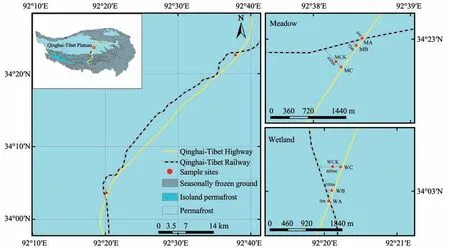
Figure 1 A geographic map showing the locations of sampling sites on the Qinghai-Tibet Plateau(QTP),China.All 24 samples(three from each of the MA,WA,MB,WB,MC,WC,MCK,and WCK sites)were collected at the same distance(10 m)from the Qinghai-Tibet Highway(QTH)roadside in alpine wetland and meadow ecotype areas.There were three replicates at each sampling site(red dots).In the naming of these samples,A,B,and C indicate increasing distance from the Qinghai-Tibet Railway(QTR)(i.e.,from near to far)
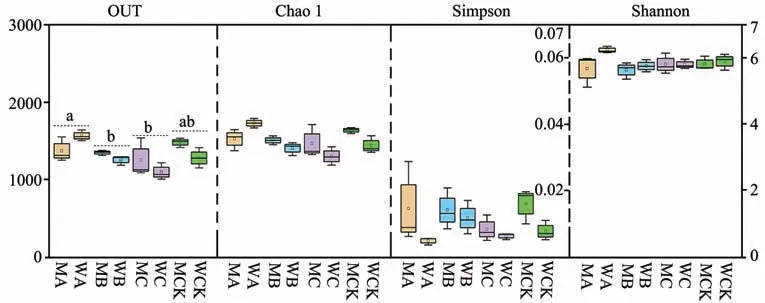
Figure 2 Richness and alpha diversity indices(operational taxonomic units(OTUs),Chao1,Shannon,and Simpson)Pooled samples from the MA,WA,MB,WB,MC,WC,MCK,and WCK sites were used to calculate alpha diversity indices
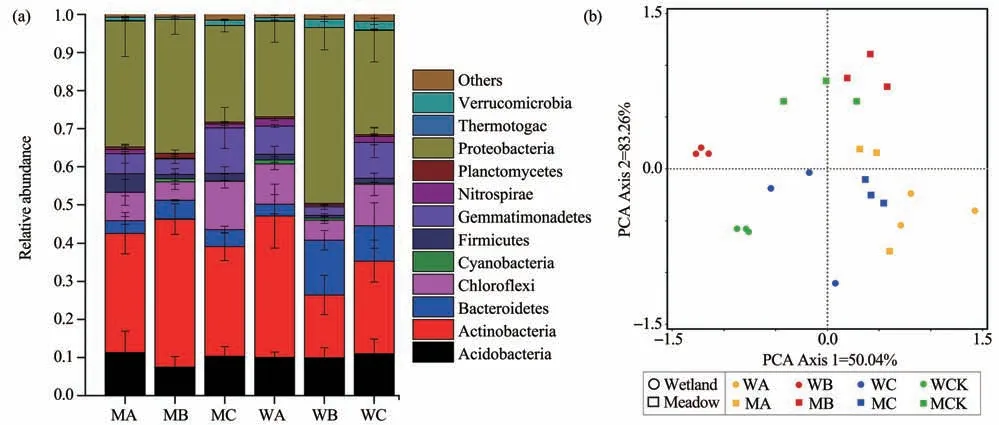
Figure 3 Phylum distribution(a)Relative abundance of the dominant bacterial phyla at different distances from the Qinghai-Tibet Highway(QTH)and Qinghai-Tibet Railway(QTR);(b)Principal component analysis(PCA)of phylum abundance data using Canoco 5.0 software
3.4 Linking environmental attributes to distance from the QTH and QTR
Seven environmental parameters (pH, total organic carbon (TOC), total nitrogen (TN), soil water content (SWC), clay, sand, and silt) were determined by soil geochemical measurements (Table S3). Among these parameters, a Spearman's correlation and CCA biplot shows that the bacterial community diversity was only significantly correlated with SWC (Table 2 and Figure 4).The concentrations of eight heavy metals(Ni,V,Co,Cr,Cd,Pb,Cu,and Zn)were measured by ICP-MS (Table 1). The Cu, Zn, Pb, Co, and Ni concentrations in each site around the QTH and QTR were higher than at each CK site. To determine the linkages between distance from the QTH and QTR and environmental attributes, Spearman's correlations were calculated. The results show that the distance from the QTH and QTR was significantly correlated with Ni, Co, and V concentrations and the SWC(Table 2).This result suggests that Ni,Co,and V concentrations in the soil were most likely related to human activity along the QTH and QTR.
3.5 Linking heavy metal concentrations and distance from the QTH and QTR to bacterial communities
The influences of environmental variables on phylum level community diversity were observed from the CCA (Figure 4). The first axis explained 36.03%of the observed microbial diversity, while the second axis explained 61.61% of the variation. For bacterial communities, the CCA results shows that Cr and Cd concentrations were positively correlated with distance from the QTH (MC/WC), and Ni, Co, and V were positively correlated with distance from the QTH and QTR (MA/WA). This suggests that heavy metal concentrations varied with distance from the QTH and QTR,which is an important factor in the divisity of bacterial community structure.
4 Discussion
The high-throughput sequencing on 16S rRNA indicated that different bacterial community compositions were present in soil at different distances from the QTH and QTR.These findings confirmed our first hypotheses.Figure 2 shows that 16S rRNA gene abundance decreased as the distance increased from the QTR and QTH in alpine wetland and meadow areas.Although, the bacterial community structure differed at different distances from the QTR and QTH in meadow and wetland areas, the trends were the same.Our findings also shows that Actinobacteria, Proteobacteria, and Acidobacteria were the main phyla in the soil, with high relative abundances of Chloroflexi,Bacteroidetes, Gemmatimonadetes, and Planctomycetesalso observed (Figure 3). The relative abundance of these phyla were significantly different from those reported in marine sediments and other soil types, indicating that bacterial communities in roadside soil can be easily distinguished from those in other environments (Chu et al., 2010; Bartram et al., 2011; Jiang et al., 2013; Shang et al., 2016). They were also differences from lake sediments on the QTP where Bacteroidetes and Firmicutes are the main phyla(Xiong et al.,2012).
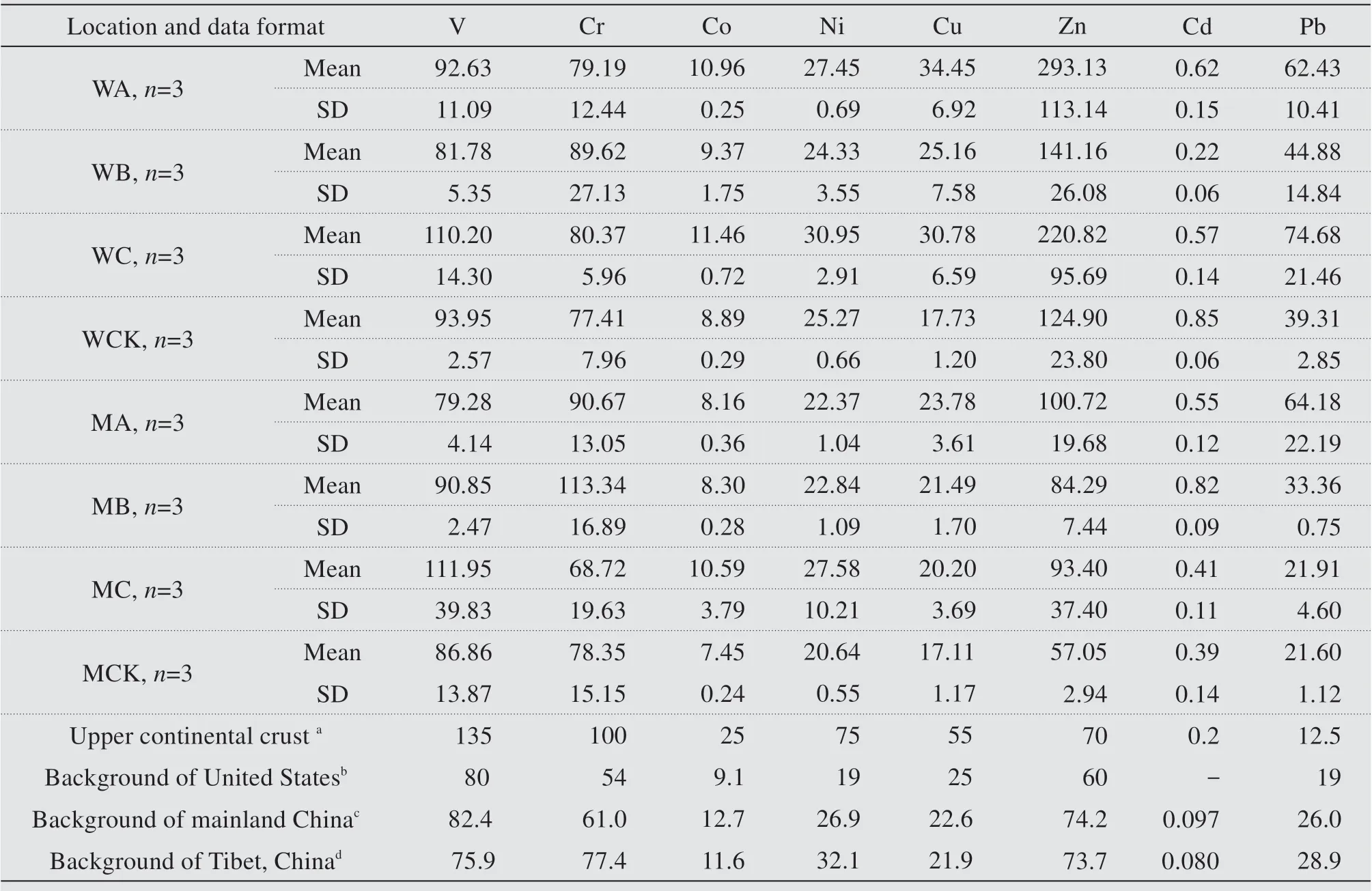
Table 1 Descriptive statistics of heavy metal concentrations(mg/kg)in soils
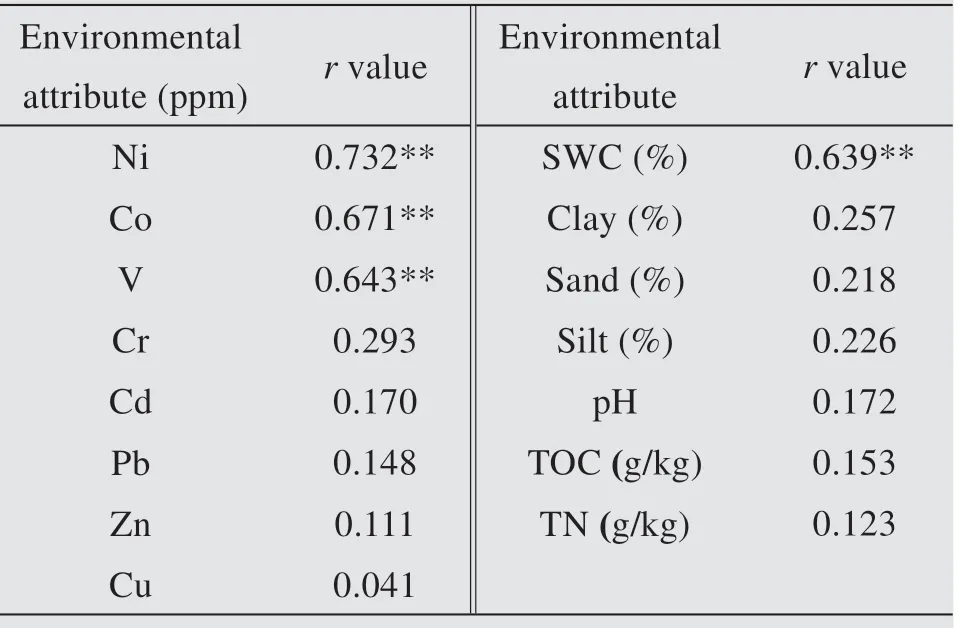
Table 2 Spearman's correlations between the distance from the Qinghai-Tibet Highway(QTH)and Qinghai-Tibet Railway(QTR)and environmental attributes in the studied soils
Some of the findings confirmed part of our second hypotheses, indicating that trends in the changes in bacterial diversity and group indicator taxa abundance variations were consistent in alpine meadow and wetland areas alongside the QTH. In Figure 2, relative OTU abundance in each sample demonstrated that in both the alpine meadow and wetland areas, the MC/WC sites (i.e., greatest distance from the QTP and QTR) had the lowest abundance of members of the microbial community, followed by the MB/WB and MA/WA sites.The Chao1 and ACE estimators also revealed apparently decreasing trends of α-diversity when moving from near to far from the QTP and QTR (i.e., WA/MA to WB/MB to WC/MC) in both ecotype areas (Table S1). Moreover, 27 potential group taxa were identified by linear discriminant analysis (LDA) in samples from the WA/MA, WB/MB,and WC/MC sites (Figure S1). Most of these taxa had consistent trends in the changes of relative abundance with distance from the QTH and QTR in both wetland and meadow ecotype areas.The trends of α-and β-diversity were also consistent with differences in distance from the QTH and QTR. To determine if variations in the relative abundance of these 27 species were influenced by the distance from the QTH and QTR,we used a histogram to show their relative abundance in wetland and meadow areas. Figure S2 only shows significant variations in species below the family level. The relative abundance of Acidimicrobiaceae, OM1_clade,Anaerolineaceae, and Gemmatimonadaceae increased(Figures S2,a-d),while that of Rhodospirillaceae and Comamonadaceae decreased (Figures S2, e and f) with increasing distance from the QTR (i.e., in MB/WB and MC/WC sites). Previous studies have reported that some genera of Rhodospirillaceae,the so-called purple non-sulfur bacteria,are diazotrophic and can be used in agricultural applications and water purification (Qiuet al., 2002; Baldani et al.,2014).Several species of the Comamonadaceae that were isolated from activated sludge (Willems,2014) are reported to be active denitrifiers in activated sludge and tannery wastewater. These species are tolerant to relatively high concentrations of chromium(III) and sulfide, and are used as denitrifying biofilms in wastewater treatment (HIRAISHI et al., 1995; Leta et al., 2004).These strains should be isolated and cultured in further studies for their potential application in environmental pollution control.
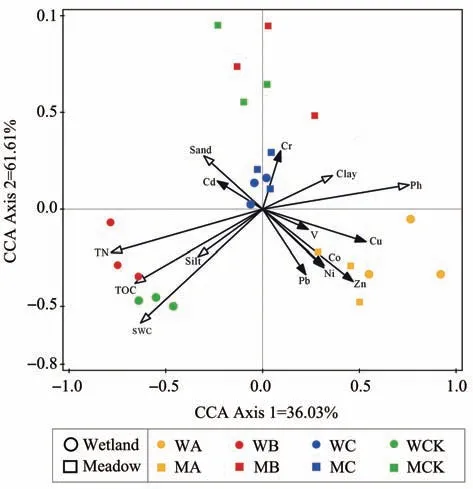
Figure 4 Canonical correspondence analysis(CCA)of environmental variables and phylum level community in samples from wetland and meadow areas.There were 15 environmental variables,including seven general physiological(TOC,TN,pH,SWC,and soil texture)and eight heavy metal(Ni,V,Co,Cr,Cd,Pb,Cu,and Zn)concentrations.TOC=total organic carbon;TN=dissolved total N;SWC=soil water content.The length of each arrow indicates the contribution of the corresponding parameter to the structural variation
Previous studies have indicated that plant production and diversity could impact microbial communities in soil and directly or indirectly mediate ecosystem processes (Bardgett and Shine, 1999;Wardle et al., 1999; Stephan et al., 2000; Marschner et al.,2001; Tilman et al., 2001; Zak et al., 2003). To minimize the effects of other factors, we collected soil samples located at a distance of 10 m from the QTH roadside,with rare plant cover and little human activity in the area. The variation in soil organic matter chemistry, soil pH, SWC, and other soil parameters impact the phylogenetic composition of soil bacterial communities (Fierer and Jackson, 2006; Lauberet al.,2009).In this study,as the distance from the QTH and QTR increased, the pH, clay, sand, and silt content,TOC, and TN did not change, although the SWC did.Heavy metals are essential for the correct functioning of biological systems, but are detrimental to human health and the environment (Suner et al., 1999; Dai et al., 2004; Ozcan and AL Juhaimi, 2012). It has been shown that railways can affect the surrounding soil,especially with regard to concentrations of some elements,i.e.,Ni,Pb,Cr,Zn,Cu,and Cd(Malawska and Wiolkomirski, 2001; Lorenzo et al., 2006; Baltrenas et al.,2009;Liu et al.,2009).In this study,heavy metal concentrations (Ni, V, Co, Cr, Cd, Pb, Cu, and Zn)in soils were measured by ICP-MS (Table 1). It was found that Ni, Co, and V were significantly related to distance from the QTH and QTR by a Spearman's correlation analysis (Table 2). The CCA analysis shows that concentrations of these heavy metals were also positively correlated with bacterial communities in MC/WC samples (Figure 4). The contents of V, Co,Zn, Ni, Pb, and Cu were strongly correlated with CCA1 which separated WA and MA from WB,WCK.This suggests that the abundance of bacterial communities within 10 m of QTR was greatly affected by heavy metals, and is less affected at 400 and 600 m.Therefore, heavy metals were found to be an important factor shaping bacterial community diversity,which confirmed our third hypothesis.
Pollution, including the large amounts of heavy metals discharged into the environment, has become a growing problem that accompanies economic development (Zhang et al., 2012). Along with industry, transportation is one of the most significant sources of heavy metal pollution (Liu et al., 2009). Since the 1970s,numerous studies have investigated heavy metal pollution in roadside environments (Motto et al., 1970;Koeleman et al., 1999; Khan et al., 2011). However,most research has focused on environmental pollution surrounding highways, with relatively little attention given to pollution resulting from railways. Some studies have found that road transport affects levels of numerous heavy metals,including Pb,Cd,Cu,Zn,Cr,Ni,Fe,Mn,Al,Co,V,Sb,Ba,Pt,Mo,Hg,Se,and As(Ho and Tai, 1988; Blake and Goulding, 2002; Li et al.,2007). As presented in Table 1, the concentrations of most metals in soils sampled during this study were higher than in the upper continental crust, with the exception of Co and Cu at the WA/MA, WB/MB, and WC/MC sites (Taylor and Mclennan, 1995).The levels of all metals were higher than their background concentrations in soils in the United States, with the exception of Co and Cu (Shacklette, 1984).The concentration of most metals in soils were higher than their background concentrations in China and Tibet, with the exception of Ni (Zhang, 1994; CEPA, 1995). The guardrails of the QTR are set within 20 to 30 m of the railway to keep local people and animals away from the tracks and polluted soil. The soil pH ranged from 8.1 to 8.55 along the QTH (Table S3). This alkaline soil reduces the migration and availability of metals(Blake and Goulding, 2002; Huang et al., 2004).Therefore, the enrichment of these metals in soils along the QTH and QTR may have little effect on local people and animals.
Acknowledgments:
This study was funded by a grant from the Cold and Arid Regions Environmental and the Engineering Research Institute of the Chinese Academy of Sciences Nos. HHS-TSS-STS-1505 and 55Y855Z11, CAS"Light of West China" Program, Frontier Science Research Program of Chineses Academy of Scienc No.QYZDJ-SSW_SMC011.
Supplementary information:

Table S1 Diversity indices used in this study

Table S2 Correlation matrix for the OUT in different QTH/QTR distance
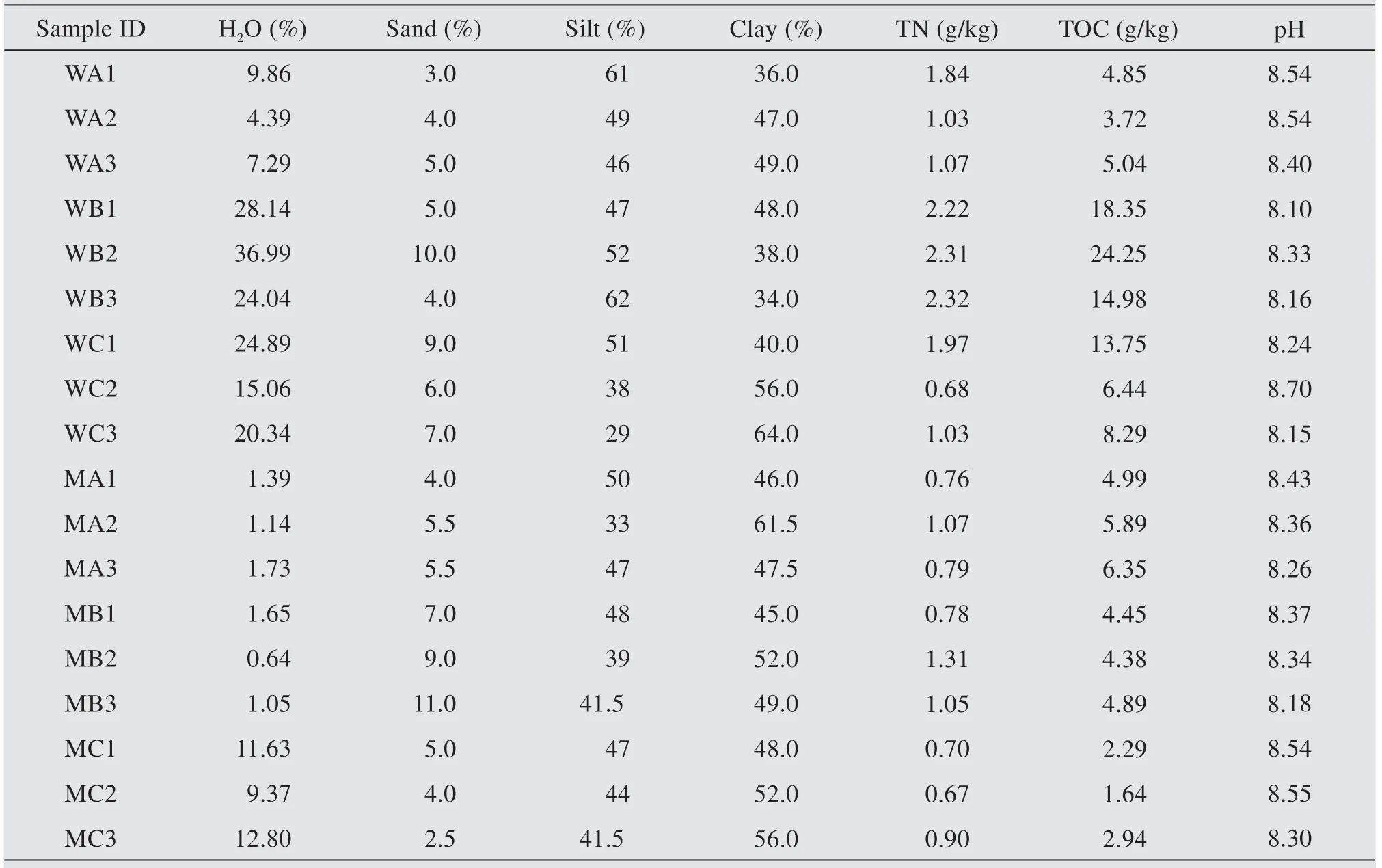
Table S3 Soil physicochemical properties
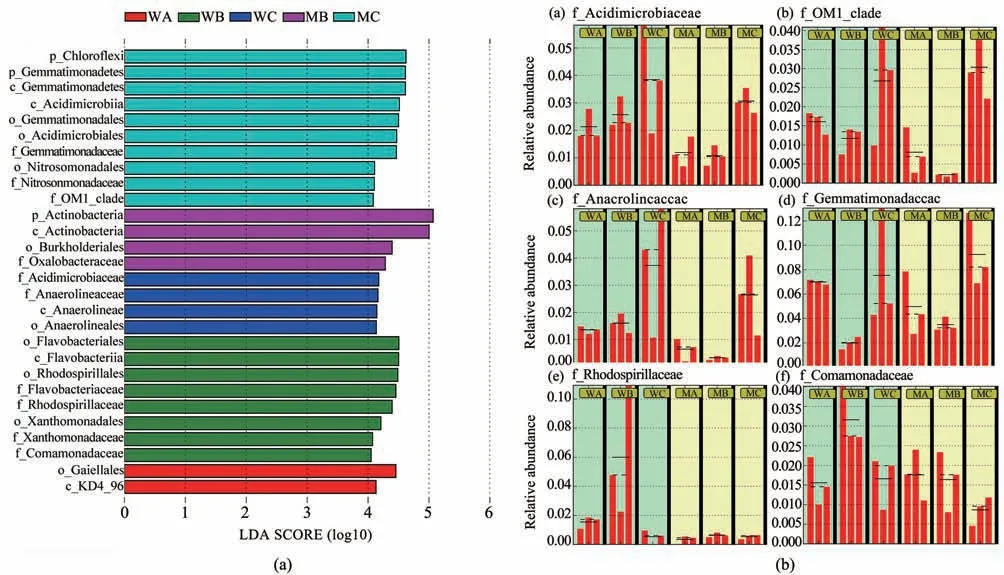
Figure S1 (a)Indicator microbial groups in alpine wetland and meadow areas with LDA score higher than 4.(b)Histogram of the significant difference taxa relative abundances in family level are differential.Wetland and meadow samples are colored with different background.The Alpine wetland was colored with blue and meadow was colored with yellow.Subclasses(distance from QTR)are separated by a black column and the mean and median of relative abundance by solid and dashed lines,respectively
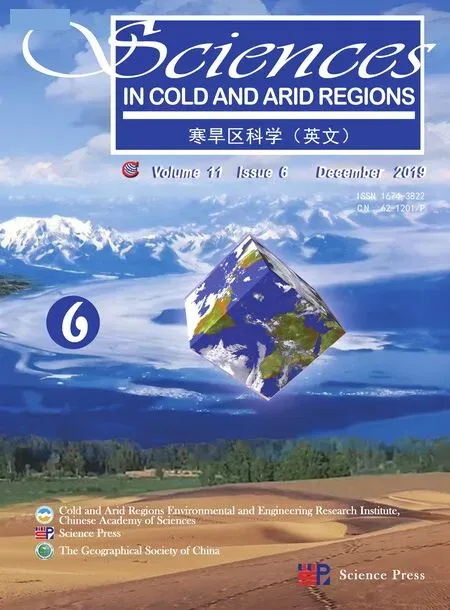 Sciences in Cold and Arid Regions2019年6期
Sciences in Cold and Arid Regions2019年6期
- Sciences in Cold and Arid Regions的其它文章
- Relationship between ponding and topographic factors along the China-Russia Crude Oil Pipeline in permafrost regions
- Editors-in-Chief Guodong Cheng and Ximing Cai
- Definition of failure criterion for frozen soil under directional shear-stress path
- Characteristics of climate and melt runoff in the Koxkar Glacier River Basin,south slope of the Tianshan Mountains,Northwest China
- Vegetation change and its response to drought in Inner Mongolia of northern China from 1998 to 2013
- An evaluation of soil moisture from AMSR-E over source area of the Yellow River,China
